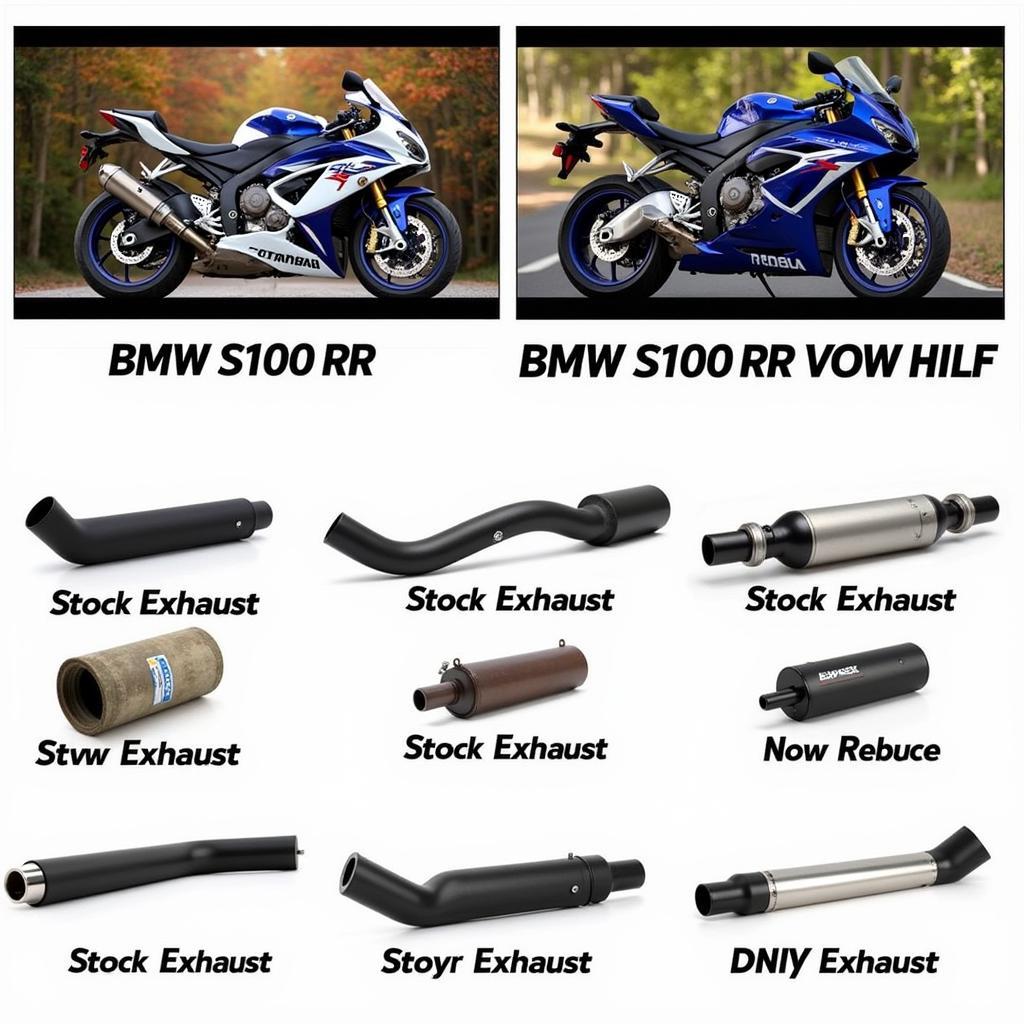The throaty rumble of a BMW S1000RR with its stock exhaust is a sound that resonates with many motorcycle enthusiasts. This article explores the nuances of the bmw s1000rr stock exhaust sound, covering everything from its characteristics to common modifications and how it compares to aftermarket options. We’ll delve into the technical aspects, discuss owner experiences, and provide valuable insights for those considering changes to their S1000RR’s exhaust system.
The BMW S1000RR’s stock exhaust note is often described as refined yet powerful. It’s a balanced sound, designed to meet regulations while still providing an exhilarating auditory experience. But what makes this sound so unique, and what are the options for those seeking a different tone? Let’s explore.
Understanding the BMW S1000RR Stock Exhaust
The stock exhaust system on the BMW S1000RR is a complex piece of engineering. It’s designed to optimize performance, adhere to noise regulations, and contribute to the overall aesthetic of the bike. Several factors influence the stock exhaust sound, including the exhaust pipe diameter, the muffler design, and the catalytic converter.
Key Components and Their Impact on Sound
- Exhaust Manifold: The manifold collects exhaust gases from the engine cylinders and channels them into the exhaust pipe. Its design affects back pressure and gas flow, influencing the overall sound.
- Catalytic Converter: This component reduces harmful emissions but can also slightly mute the exhaust note.
- Muffler: The muffler is the primary component responsible for shaping the sound of the exhaust. The internal baffles and chambers determine the final tone and volume.
Comparing Stock vs. Aftermarket Exhausts
Many riders opt to upgrade to an aftermarket exhaust system to personalize their S1000RR’s sound. Aftermarket exhausts offer a wider range of sound profiles, from deep and aggressive to high-pitched and screaming. However, this often comes at the cost of increased noise levels and potential legal issues.
Performance and Sound Considerations
While some aftermarket exhausts can offer slight performance gains, often the primary motivation for switching is the sound. It’s important to carefully consider the trade-offs between performance, sound, and legality before making a change.
Looking for a way to enhance your BMW’s audio system? Check out the bmw audio adapter cable.
Why Do Riders Change Their Exhaust?
The most common reason riders change their exhaust is to achieve a more desirable sound. Some find the stock exhaust too quiet, while others prefer a deeper, more aggressive tone. For some, aesthetics also play a role.
Is it Worth Changing the Stock Exhaust?
The decision to change the stock exhaust is a personal one. Factors to consider include budget, desired sound, and local regulations. It’s always advisable to research thoroughly and listen to sound clips of different exhaust options before making a purchase.
If you’re looking for BMW audio solutions, the grom bmw audio adapter might be a good option.
 BMW S1000RR Exhaust Sound Comparison
BMW S1000RR Exhaust Sound Comparison
Conclusion
The bmw s1000rr stock exhaust sound is a key element of the bike’s character. Whether you prefer the refined tone of the stock system or the roar of an aftermarket exhaust, understanding the factors that influence the sound is crucial. By weighing the pros and cons of each option, you can make an informed decision that aligns with your riding style and preferences.
FAQ
- Is the stock exhaust legal? Yes, the stock exhaust meets all regulations.
- Can I improve performance with an aftermarket exhaust? Some aftermarket exhausts can offer slight performance gains.
- Will an aftermarket exhaust void my warranty? It depends on the specific modification and the warranty terms.
- How loud is the stock exhaust? It is designed to be within legal noise limits.
- What are the most popular aftermarket exhaust brands? Akrapovic, Yoshimura, and Arrow are popular choices.
- How much does an aftermarket exhaust cost? Prices vary widely depending on the brand and material.
- Do I need a tune after installing an aftermarket exhaust? It’s recommended, but not always required.
You can enhance your BMW’s audio with the bmw auxiliary audio input cable adapter. For 2008 models, check out the audio adapter 2008 bmw. Also, consider the grom audio bmw sb3 bluetooth adapter for Bluetooth connectivity.
Need help with your BMW? Contact us on Whatsapp: +1 (641) 206-8880, Email: CARDIAGTECH[email protected] or visit us at 276 Reock St, City of Orange, NJ 07050, United States. We offer 24/7 customer support.

